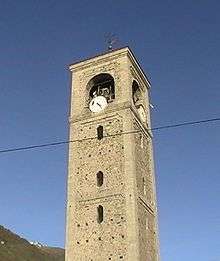Sondrio
Sondrio is a town of 22,000 people (2018) in Sondrio Province in the Lombardy region of northern Italy.
Understand
The territory of Sondrio has numerous vineyards; wines produced include the Sassella and Grumello. Wine represents one of the main resources of this region, together with tourism, especially in winter.
Another important piece of Sondrio's economy is its banking industry. The Banca Popolare di Sondrio and the Credito Valtellinese are headquartered in Sondrio and listed on the Milan Stock Exchange.
History
Formerly an Ancient Roman military camp, today's Sondrio was founded by the Lombards: in their language Sundrium meant "Exclusive property", referring to the status of free men (arimanni) of the holders of the city and the surrounding land.
After the fall of the Lombard Kingdom in Italy, Sondrio became part of the Holy Roman Empire. The Capitanei of Vizzola, who controlled much of the Valtellina, had it in 1040 from the emperor Henry II. From 1310 to 1335 the city was involved in the war between the Guelph and Ghibelline factions of the nearby Como, and its war against Milan. After having resisted several attacks by the Comaschi, in 1335 Sondrio and Valtellina became part of the Visconti Milanese dominions.
From the second half of the 16th century to the end of 18th century, Sondrio was governed by the Tre Leghe Grigie ("Three Grey Leagues") of the Grisons, as the capital city of Valtellina. After the Reformation, Sondrio was the centre of major struggles between the Catholic Valtellinesi and the Protestant Grisons. In 1620 the citizens, led by Giacomo Robustelli, killed 180 Protestants and declared the independence of the Valtellina.
After the Napoleonic parenthesis, in which it became part of the Cisalpine Republic (later Kingdom of Italy), Sondrio with the Valtellina was annexed to the Austrian Kingdom of Lombardy-Venetia, and fought gallantly for its independence.
Get in
Get around
See

The heart of Sondrio is its central Garibaldi Square. Not far from it is the Palazzo Sassi, that is home of the Art and History Museum of Valtellina. In a dominant position, near the ancient road to the Valmalenco, linking the town to Switzerland, stands the Masegra Castle, housing the Historical Museum of the Grisons Domination.
Other sights include the Torre Ligariana, once the collegiate's bell tower, and the Palazzo Pretorio, once the seat of the Grisons government.
- 🌍 Valtellinese Museum of History and Art (Museo valtellinese di storia e arte), ☎ +39 0342 526269, e-mail: museo@comune.sondrio.it. €6.
- 🌍 Church of Stt. Gervasius and Protasius (Chiesa collegiata dei Santi Gervasio e Protasio). It was built in the 12th century and rebuilt in Neoclassical-style in 1838.
Do
Buy
Eat
Drink
Sleep
- Hotel Santa Caterina, Via Freita, 9 Santa Caterina Valfurva, ☎ +39 0342 925123. Check-in: 16:00, check-out: 10:00. Centrally located three-star accommodation. €110.